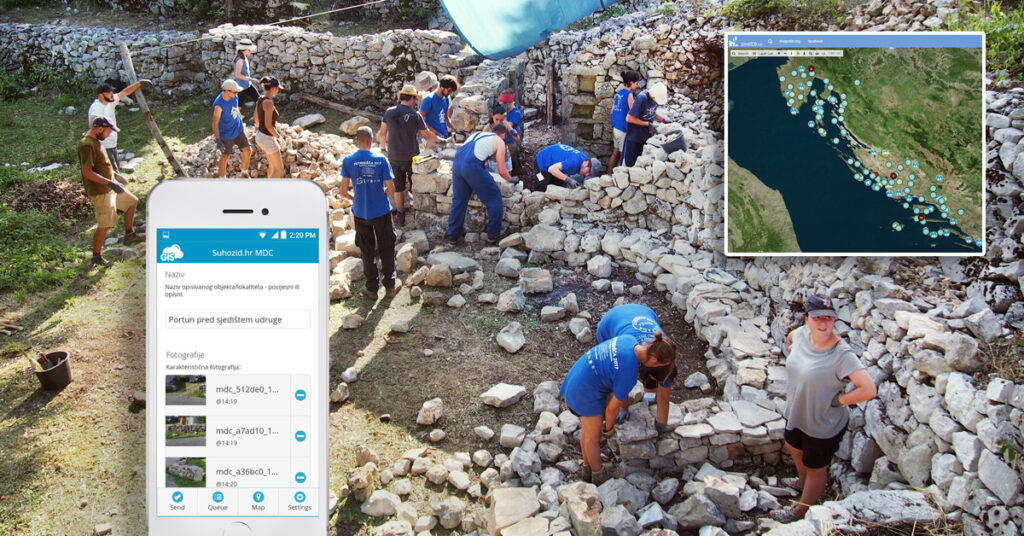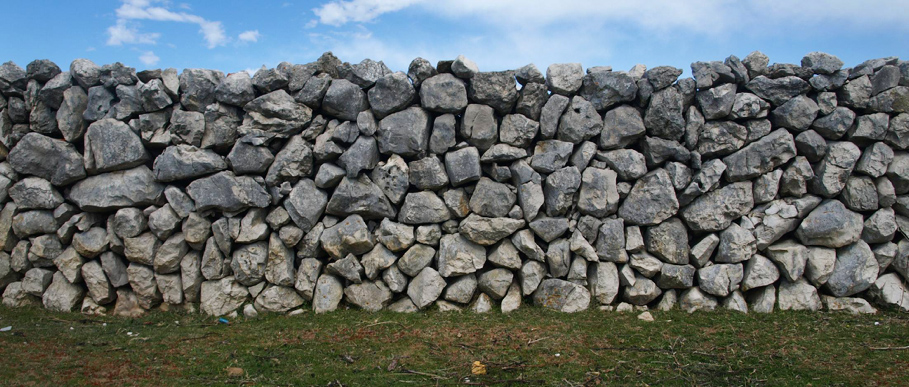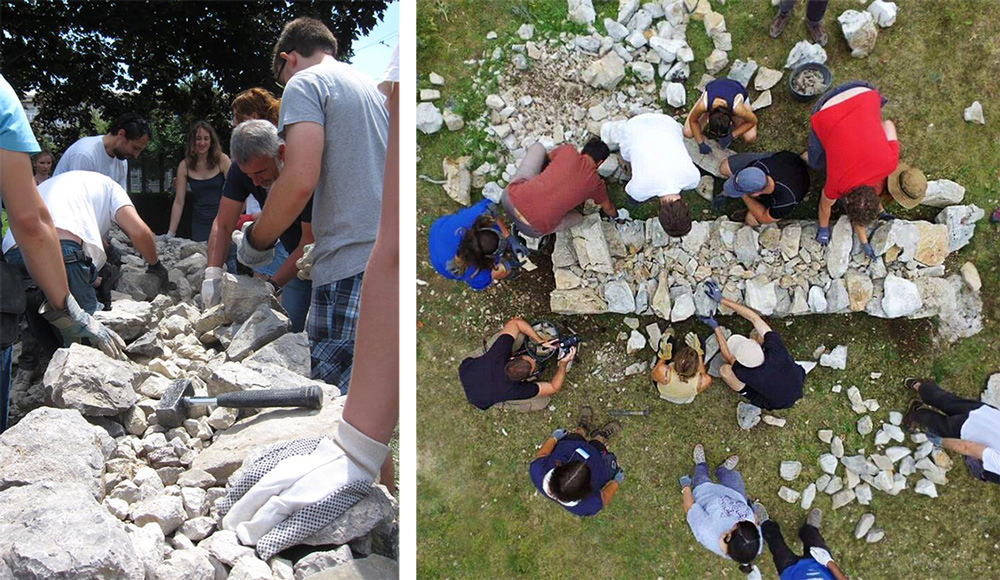We had the pleasure to work with 4 GRADA DRAGODID, an NGO working on restoring and preserving the dry stone in Croatia. We got to know them during the GIS Day Contest 2016 where they won the special award, GIS Cloud solution for field data collection, map editing and a public map portal.
GIS Cloud mapping solution enabled the nonprofit to continue their project that almost came to a stop because their previous mapping solution was too complicated to develop and maintain. The collaboration resulted in suhozid.hr, an interactive Map Portal showing locations of the dry stone localities and its historical data throughout Croatia.

We spoke with Grga Frangeš from 4 GRADA DRAGODID, who explained the organization’s activities, their project Suhozid.hr, as well as their goals and plans for the future. But, let’s start with a quick introduction about dry stone in Croatia.
The importance of dry stone as cultural heritage
Although at first glance dry stone wall construction may appear to be an uninteresting, even ‘primitive’ type of structure, its importance needs to be assessed from a wider perspective. In a literal, visual sense, the ‘wider perspective’ is available to us through aerial and satellite imagery visualized using web mapping technologies. When we take a look at the dry stone construction, we will see that they are widespread in the karst areas, where the stone is the principal material in the landscape.
In areas populated with human settlements, the stone is also considered ‘an excess,’ that has to be removed or put to a particular use in order to survive in an often inhospitable environment. From a cultural or less literal perspective, the dry stone heritage represents a kind of the “infrastructure of survival” through which people have tailored and modified the merciless environment to their life needs.

“An example of the dry stone wall. Dry stone is a stone wall that is made without mortar to hold the stones together (Merriam-Webster)”
The historical significance of dry stone in Croatia
The skill of dry stone building and drywall construction is a traditional legacy of the Mediterranean area even from prehistoric times. This ancient building skill shaped the eastern Adriatic as it is today. For centuries people laid stone on top of stone creating impressive structures.
The dry stone had many applications that were essential for local communities. Dry stone walls prevented livestock from fleeing, and the walls doubled as boundaries between properties. Also, people would sift through dirt and extract the rocks to make it suitable for cultivation. The rocks were then used for building the dry stone. It was a cumbersome type of work that was essential for local communities.
The nonprofit behind suhozid.hr
4 GRADA DRAGODID is a nonprofit organization dedicated to the preservation and restoration of the dry stone walls in Croatia and the Eastern Adriatic, as well as educating and informing the public about dry stone heritage, its history, function, and importance.

Photo Credits: 4 GRADA DRAGODID
The organization was established in 2007, but their first activities date back to 2002 when the first international dry stone workshop was held in Dragodid, a village in the vicinity of Komiža, the island of Vis (Croatia). Today, they are present in various localities throughout the Croatian coast and nearby countries.
4 GRADA DRAGODID has 40 members, and their main activities consist of organizing dry stone workshops in different locations, and research into the dry stone heritage in collaboration with local dry stone artisans.
The beginnings of Suhozid.hr project
Having in mind the scale of the dry stone heritage and its importance for the local culture, the primary goal of the project was to map various dry stone localities in order to preserve the heritage and raise awareness of its importance using GIS technology.
The idea was conceived and the domain Suhozid.hr was registered by ethnologist Jadran Kale, architect Filip Šrajer from 4 GRADA DRAGODID operationalized it into a project assignment and contacted Dražen Odobašić who developed the system’s architecture. The project was named “The open public inventory of Croatian dry stone walls.”
The first stage of the project was launched in 2013, a customized web solution was implemented with a PostGIS database built on a Linux VPS server, visualized and published using a custom web GIS interface built on OpenLayers technology.
During 4 years of continuous work, more than 3200 entries that included GPS locations, dry stone photos, and descriptions were collected by the members of the 4 GRADA DRAGODID organization.
Their next goal was to build a community of people who would be motivated to contribute to the project with a system that would encourage social interaction within the community by rewarding the most active members and those with the best data collection contributions.
Challenges with the initial mapping solution
The initial advantage of the project, its customizability gained by web development efforts of the volunteers, proved to be a disadvantage in the long term.
Namely, as the whole project was based on the volunteer work, the first problems arose when the developers didn’t have enough time to spare to continue the maintenance, upgrades, and administration of the project. Because the web solution they had was unique and custom, and it didn’t have sufficient documentation and details necessary for the knowledge transfer that would allow other volunteers to take over, the project came to a halt.
What they needed to continue the project was a simpler solution that wouldn’t require additional web development skills from the volunteers, and that would be easy to update, customize, and maintain.
For some time, there was no sign that the volunteers would be able to continue the project. However, the project came to a turning point when the team from 4 GRADA DRAGODID got an opportunity to revitalize their project after they learned about the GIS Day Contest in 2016.
The GIS Day Contest was conceived as a platform to support the realization of mapping projects that contribute to a local community by providing the necessary tools and technical support for their realization. They decided to enter the contest and got selected as one of the contest’s special award winners in the category of nonprofit organizations.
It meant that they finally had the means to revive the project, this time on top of the GIS Cloud platform, and with the help of the GIS Cloud team.

Photo Credits: 4 GRADA DRAGODID
Preparing the data for the new GIS solution
The solution provided by GIS Cloud proved to be the best way to continue and overcome the challenge of maintaining the project with easy-to-use tools which don’t require web development skills from the volunteers working on the project.
First, the most significant technical effort was put forth in consolidation and adjustment of the original PostGIS database data structure. The original PostGIS database needed adjustment for several requirements before the connection could be established, like ensuring that the user and PostGIS tables have the relevant database permissions necessary to read them, modifying the column names connected to feature geometry and primary keys (ID), etc.
After the initial phase finished, the further steps were rather simple, and the implementation of the new solution went smoothly.
One of the most important GIS Cloud features for the project was establishing a link with the external PostGIS server using a secure SSL connection. Maintaining the database on their servers meant that 4 GRADA DRAGODID could retain full control of the access and use of their data.
Besides the importance of establishing a link between external PostGIS database and GIS Cloud, one of the significant advantages was the option to manage the external PostGIS database directly in GIS Cloud. It offers the ability to import and/or delete shapefiles or CSV/XLS files in your external database, to modify and edit the features and attribute data from tables. As an addition, the external PostGIS database can be connected to the Mobile Data Collection app so the collected field data can be stored directly in the external PostGIS database.
GIS Cloud solution for field data collection, map editing and a public Map Portal
The map of dry stone localities was easily modified and styled in the Map Editor, which also had options to add custom symbology for different attributes on the map.
For data collection, the nonprofit used Mobile Data Collection application. It proved to be a very intuitive tool that brought the fieldwork to the next level as the custom data collection forms can be set up really fast and with useful features such as offline data collection.

An example of the data collection form used for the project
The new portal was published using GIS Cloud Map Portal, enabling simple customization through App Builder, in which a fully custom interface can be built without having to write a single line of code. You can see the result of the project in the map below (direct link to the portal).
The future plans: Crowdsourcing solution
Currently, the 4 GRADA DRAGODID team is striving to improve the quality of the data they have already collected while collecting new data for which they now have new standards of quality and structure.
They plan to extend their project using GIS Cloud Crowdsourcing solution that would allow for anybody interested in the dry stone heritage to contribute to the data collection process, regardless of their expertise and technical ability. As with the Mobile Data Collection application, the data quality can be easily controlled by setting up predefined fields as required or optional in the custom form.
The dry stone craftsmanship has recently been protected as a part of intangible Croatian cultural heritage, and it is expected to be put by UNESCO on a list of the intangible cultural heritage of humanity. As 4 GRADA DRAGODID is intensively involved in this process of protecting the dry stone heritage, their next goal is to publish a new dataset on the Suhozid.hr Portal, with data about bearers of this cultural heritage and the active dry stone masters/builders/craftsmen available for engagement in different projects with their contact information. With this, the organization wants to contribute to the professionalization of this craft, which is also one of the preconditions of its survival into the future.

To learn more about Suhozid.hr and 4 GRADA DRAGODID, visit their homepage.
If you are interested in our Crowdsourcing solution, contact us.







